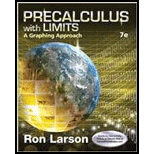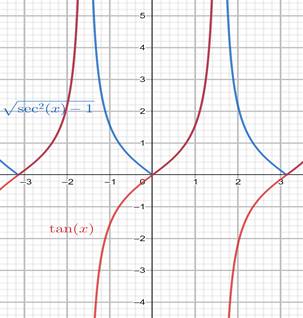
Concept explainers
To explain: Why the given equation is not an identity and find one value of the variable for which the equation is not true.
Explanation of Solution
Given information:
The following equation:
√sec2x−1=tanx
Formula used:
The following identity:
1+tan2x=sec2x
The equation can be simplified as:
√sec2x−1=tanx√tan2x=tanx [Pythagorean identity]±tanx≠tanx [Square root]
The left hand side is not equal to the right hand side. Hence the equation is not an identity.
Let x=2π3
Substituting value of x on left hand side of the equation,
√sec2x−1=√sec22π3−1 [Substitute value of x]=√(−2)2−1 [Put value of sec 2π3]=√4−1 [Square]=√3 [Subtract]
Substituting value of x on right hand side of the equation,
tanx=tan2π3 [Substitute value of x]=−√3 [Put value of tan2π3]
The value on the left hand side is not equal to the value on the right hand side.
Hence for x=2π3 , the equation is not true
Also, the given equation is not an identity because the expressions on the left hand side and the right hand side when plotted on a graph, do not coincide.
Graph:
Sketch the graph using graphing utility.
Step 1: Press WINDOW button to access the Window editor.
Step 2: Press Y= button.
Step 3: Enter the expressions Y1=√sec2x−1 and Y2=tanx which is required to graph.
Step 4: Press GRAPH button to graph the function.
The graph is obtained as:

Interpretation:
The graphs of the left hand side expression and the right hand side expression do no coincide.
Chapter 5 Solutions
Precalculus with Limits: A Graphing Approach
- Find the accumulated amount A, if the principal P is invested at an interest rate of r per year for t years. (Round your answer to the nearest cent.) P = $3800, r = 4%, t = 10, compounded semiannually A = $ 5645.60 × Need Help? Read It SUBMIT ANSWER [3.33/6.66 Points] DETAILS MY NOTES REVIOUS ANSWERS ASK YOUR TEACHER TANAPCALC10 5.3.001.EP. PRACTICE ANOTHER Consider the following where the principal P is invested at an interest rate of r per year for t years. P = $3,100, r = 4%, t = 10, compounded semiannually Determine m, the number of conversion periods per year. 2 Find the accumulated amount A (in dollars). (Round your answer to the nearest cent.) A = $ 4604.44arrow_forwardForce with 800 N and 400 N are acting on a machine part at 30° and 60°, respectively with a positive x axis, Draw the diagram representing this situationarrow_forwardI forgot to mention to you to solve question 1 and 2. Can you solve it using all data that given in the pict i given and can you teach me about that.arrow_forward
 Calculus: Early TranscendentalsCalculusISBN:9781285741550Author:James StewartPublisher:Cengage Learning
Calculus: Early TranscendentalsCalculusISBN:9781285741550Author:James StewartPublisher:Cengage Learning Thomas' Calculus (14th Edition)CalculusISBN:9780134438986Author:Joel R. Hass, Christopher E. Heil, Maurice D. WeirPublisher:PEARSON
Thomas' Calculus (14th Edition)CalculusISBN:9780134438986Author:Joel R. Hass, Christopher E. Heil, Maurice D. WeirPublisher:PEARSON Calculus: Early Transcendentals (3rd Edition)CalculusISBN:9780134763644Author:William L. Briggs, Lyle Cochran, Bernard Gillett, Eric SchulzPublisher:PEARSON
Calculus: Early Transcendentals (3rd Edition)CalculusISBN:9780134763644Author:William L. Briggs, Lyle Cochran, Bernard Gillett, Eric SchulzPublisher:PEARSON Calculus: Early TranscendentalsCalculusISBN:9781319050740Author:Jon Rogawski, Colin Adams, Robert FranzosaPublisher:W. H. Freeman
Calculus: Early TranscendentalsCalculusISBN:9781319050740Author:Jon Rogawski, Colin Adams, Robert FranzosaPublisher:W. H. Freeman
 Calculus: Early Transcendental FunctionsCalculusISBN:9781337552516Author:Ron Larson, Bruce H. EdwardsPublisher:Cengage Learning
Calculus: Early Transcendental FunctionsCalculusISBN:9781337552516Author:Ron Larson, Bruce H. EdwardsPublisher:Cengage Learning





